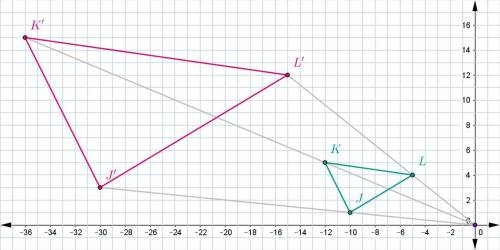
Mathematics, 09.04.2020 20:22 baby851
Consider triangles JKL and J′K′L′, with J(−10,1), K(−12,5), L(−5,4), J′(−30,3), K′(−36,15), and L′(−15,12).
A: What is the scale factor, k, for the dilation that takes △JKL to △J′K′L′?
B: What is the mapping statement for this dilation?
Select two answer choices: one for Question A, and one for Question B.
A: k=−3
B: (x, y)↦(−3x,−3y)
A: k=13
A: k=3
B: (x, y)↦(3x,3y)
B: (x, y)↦(13x,13y)


Answers: 3


Other questions on the subject: Mathematics

Mathematics, 21.06.2019 18:00, josephvcarter
Polygon hh is a scaled copy of polygon gg using a scale factor of 1/4. polygon h's area is what fraction of polygon g's area?
Answers: 3

Mathematics, 21.06.2019 20:00, claudia3776
What does the sign of the slope tell you about a line?
Answers: 2

Mathematics, 21.06.2019 21:00, nathanwhite2000
What is the similarity ratio of a cube with volume 729m^3 to a cube with volume 3375 m^3
Answers: 2
You know the right answer?
Consider triangles JKL and J′K′L′, with J(−10,1), K(−12,5), L(−5,4), J′(−30,3), K′(−36,15), and L′(−...
Questions in other subjects:





Social Studies, 03.03.2020 20:02

Mathematics, 03.03.2020 20:02

Chemistry, 03.03.2020 20:02


Mathematics, 03.03.2020 20:02



